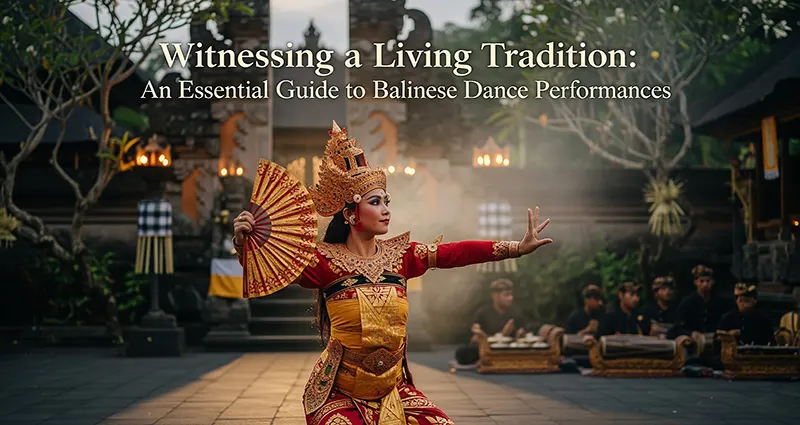A trip to Bali is incomplete without experiencing the island’s vibrant and mesmerizing traditional dance performances. More than just a form of entertainment, these dances are a profound expression of Balinese Hindu spirituality, mythology, and art. Each graceful movement, intricate costume, and expressive facial gesture tells a story, often accompanied by the enchanting, hypnotic sounds of a live gamelan orchestra.
While you can find performances across the island, the cultural heart of Bali, Ubud, is the best place to witness these authentic art forms. Here’s a guide to some of the most famous dance shows and practical information on where to see them.
The Iconic Balinese Dances You Must See
- Kecak and Fire Dance: This is arguably the most famous and dramatic of all Balinese dances. Performed by a circle of at least 100 men chanting the rhythmic “cak-cak-cak” sound, the dance tells the story of the Ramayana epic. The performance culminates in a breathtaking fire dance, where a dancer seemingly walks unharmed through hot coals. The most popular venue for this is the open-air amphitheater at Uluwatu Temple, where the performance takes place against the backdrop of a stunning sunset over the Indian Ocean.
- Legong Dance: A highly refined and captivating dance, the Legong is traditionally performed by young, pre-pubescent girls. Their movements are characterized by intricate finger gestures, darting eyes, and graceful footwork. The dance often depicts a royal court drama, and the synchronized movements of the dancers are truly a sight to behold.
- Barong and Kris Dance: This powerful dance portrays the eternal struggle between good and evil. The Barong, a mythical lion-like creature representing good, battles Rangda, a terrifying demon queen symbolizing evil. The climax of the performance sees the dancers, in a trance-like state, turning their kris (daggers) on themselves, a ritualistic act of self-defense against Rangda’s dark magic.
Performance Schedules and Venues in Ubud
Ubud is a hub for Balinese dance, with multiple venues offering performances nightly. While schedules can sometimes change, here is a general overview of some of the most popular and authentic venues:
- Ubud Palace (Puri Saren Agung): This is one of the most accessible and well-known venues, located right in the heart of Ubud. Different dance troupes perform on different nights of the week, often starting around 7:30 PM. A typical week might feature a mix of Legong, Barong, and other traditional dances.
- Saraswati Temple (Pura Taman Saraswati): This temple, with its beautiful lotus pond and stunning architecture, provides a magical setting for a dance performance. Shows are often held several nights a week, with a focus on classical dances like the Legong and other ceremonial performances.
- Padang Tegal Kaja Temple: This venue, located a short walk from the famous Monkey Forest, offers a more community-driven and authentic experience. They often feature Kecak and Fire Dance on certain nights, showcasing the dance’s powerful chanting and storytelling.
- Agung Rai Museum of Art (ARMA): This museum offers performances in a beautiful, artistic setting. The schedule often varies, so it’s best to check with the museum directly. ARMA is known for its high-quality performances and tranquil surroundings.
Ticket Prices and Essential Tips
- Ticket Prices: For most performances in Ubud, ticket prices are standardized and very affordable, typically ranging from IDR 100,000 to IDR 150,000 (approximately $6.50 to $10.00 USD) per person. Children under a certain age may have a reduced price or free entry.
- Where to Buy: Tickets are most commonly purchased on the day of the show. You will find people selling tickets along the streets of Ubud, particularly in the afternoon, or you can buy them directly at the venue’s ticket counter, which opens a few hours before the performance. For very popular shows, such as the Uluwatu Temple Kecak dance, it’s recommended to arrive early to ensure you get a seat.
- Important Notes:
- Dress respectfully: Since many performances are held at or near temples, it is appropriate to wear a sarong and a sash, which can often be rented or provided at the entrance.
- Arrive early: Seating is almost always on a first-come, first-served basis. Arriving 30-45 minutes before the show starts will help you secure a good seat.
- Check the schedule: Always double-check the specific dance being performed and the start time for the day you plan to attend, as it can vary by location.
Attending a Balinese dance performance is a transformative experience that allows you to connect with the island’s spiritual and artistic heritage. By planning ahead and choosing a venue that fits your interests, you can ensure a truly authentic and unforgettable evening.










